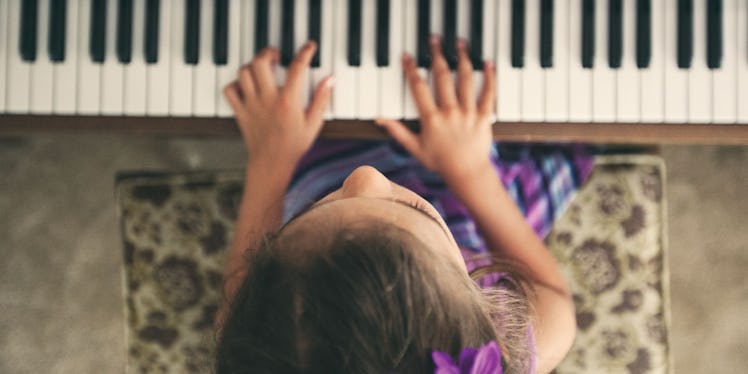This Is Your Kid’s Brain On Music
One more reason to start a family band.

The following was produced in partnership with our friends at KinderCare.
With apologies to any of you who actually bought the headphones, the so-called “Mozart Effect” — the idea that playing classical music for kids in utero makes them come out smarter — has been debunked. However, the social, emotional, and cognitive benefits of music education have been well documented, and current research is out to prove the academic benefits start kicking in as early as preschool.
Music Literally Helps The Stuff Between Your Ears
An ongoing study led by Assal Habibi, Senior Research Associate at the University of Southern California’s Brain and Creativity Institute, has already shown that music education can accelerate children’s cognitive development. So while you might not have been able to make them smarter in utero, you can use music to promote academic success now that they’re here. That should be music to your ears, even if Serenade No. 13 on recorder in E-flat isn’t just yet.
Dr. Habibi’s 5-year study has been tracking a group of 6- and 7-year-olds in the Los Angeles Philharmonic’s “Youth Orchestra Los Angeles” program. She believes the research to be equally applicable to younger, preschool-age kids — it’s just harder to make them sit down long enough to study them. Dr. Habibi’s team then compared the music kids to a group involved in typical after-school youth sports, and another with no regular after-school activities; none of the groups had any prior music training. After one year, the music kids were better able than the others to memorize a series of numbers. After 2 years, neuro-imaging data showed the music kids’ auditory pathways — the ear-to-brain connections where sounds get translated — were rapidly developing.
A more developed auditory pathway means faster, more efficient processing of all sound, Dr. Habibi says. That includes the sounds coming out of a teacher’s face in a future classroom where listening to and retrieving that information is critical to success. That, Dr. Habibi hypothesizes, means that kids who get music education early (yes, even shaking maracas in the big preschool spring showcase) will excel in their general education later.
Did you catch all that — or are your auditory pathways not developed enough?
What You Can Do With This
According to Meg Davis, Manager Of Curriculum Development at KinderCare, music is so innate to children that your job as de facto music teacher becomes extremely simple: make music a part of their experience every day. You can jam to your favorites, of course (how else is the kid gonna develop a superiority complex over their friends?), or make it a discovery exercise for both of you by offering selections from other countries and cultures. Either way, they’re gonna do that adorable booty shake move. “They almost can’t help themselves,” Davis says.
Other easy ways to make your kid’s life more musical: keep musical instruments around for them to experiment on. Sing. Bang out your own beats on pots and pans. For crying out loud, cry out loud! Your kid learns best through their senses and expresses their feelings through movement, Davis says, so give them ample opportunity to hear, make, and move to the sounds of music.
As you get more advanced with your preschooler’s at-home music education, the core things you’ll want to emphasize are movement, social interaction, language recognition, confidence, creativity, awareness of cause and effect, and pattern recognition. Here’s a Cliff’s Notes version of some musical activities you can try (no data on whether Cliff’s Notes yield better grades; your high school English teacher is betting no):
Sing Songs: Whether your favorite jam is “Head, Shoulders, Knees and Toes” or the “Star Spangled Banner,” encourage the kid to repeat after you or join in any way they can. This promotes language recognition … and patriotism. (Ages: 1-2 years)
Play Sounds: You make a beat, they repeat. That’s patterning and sequencing, which is also super helpful for math. Describe how we use our ears to listen for loud sounds and soft sounds. Ask pretty much anything sound-related that you can think of: “How does loud clapping sound?” “How does soft stomping sound?” “Which one makes daddy’s head hurt?” When you run out of sound-making movements, do all of the above with instruments. Continue until your wife returns home with ibuprofen. (Ages: 1-3 years)
Dance: Mix the singing with the sounds and urge them to move creatively however they want. Keep the open-ended questions coming. “How can you move?” This is a great group activity for building kids’ body awareness — how they can move and how their bodies relate to others in shared spaces. Better they learn now than by spinning in circles in the back row of a Phish show in 15 years. (Ages 2-4 years)
All Together, Now: Sing the song and let them have at it — they can sing along, dance along, play along, or all 3. They can stage an elaborate production with their cousins in the living room. They can force you to watch it 17 times in a row. You can watch attentively and applaud wildly for the big finish. Yes, every time. This builds their self-confidence, promotes social interactions, and affirms their abilities to make stuff. (Ages: 3-5 years)
Any of the above can be turned into group activities and combined with other types of projects like arts and crafts — kids can make their own instruments or cut out paper shapes and use them as props. If it’s musical and interactive, it’s probably helping them with creative expression, social and emotional development, and language and literacy development. As for their music literacy, that’s what “Dad’s Carpool Playlist” is for.
This article was originally published on